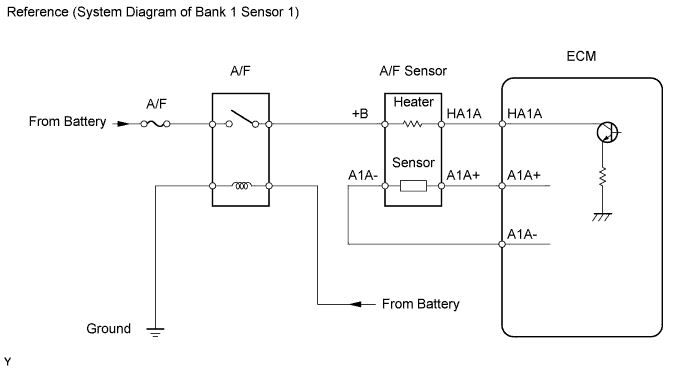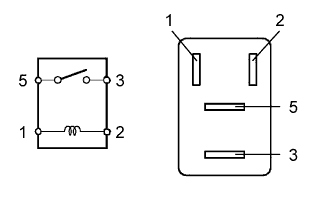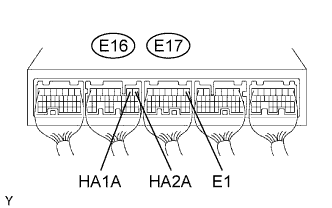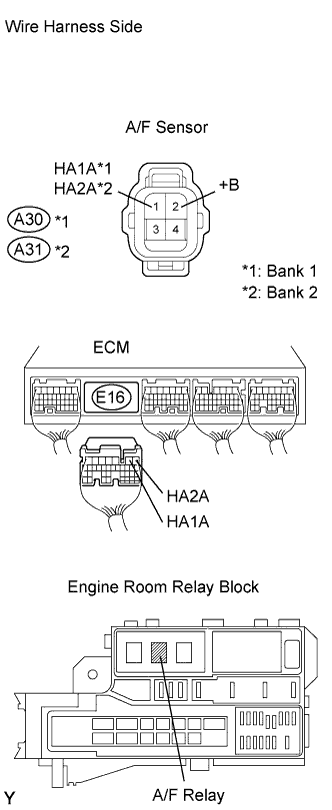Dtc P0031 Oxygen (A/F) Sensor Heater Control Circuit Low (Bank 1 Sensor 1)
DESCRIPTION
MONITOR DESCRIPTION
WIRING DIAGRAM
INSPECTION PROCEDURE
INSPECT AIR FUEL RATIO SENSOR (HEATER RESISTANCE)
INSPECT A/F RELAY (Marking: A/F)
CHECK ECM (HA1A, HA2A VOLTAGE)
CHECK WIRE HARNESS (A/F SENSOR - ECM AND A/F RELAY)
DTC P0031 Oxygen (A/F) Sensor Heater Control Circuit Low (Bank 1 Sensor 1) |
DTC P0032 Oxygen (A/F) Sensor Heater Control Circuit High (Bank 1 Sensor 1) |
DTC P0051 Oxygen (A/F) Sensor Heater Control Circuit Low (Bank 2 Sensor 1) |
DTC P0052 Oxygen (A/F) Sensor Heater Control Circuit High (Bank 2 Sensor 1) |
DESCRIPTION
Refer to DTC P2195 (Toyota Fortuner RM000000XOK010X.html).- HINT:
- When any of these DTCs are set, the ECM enters fail-safe mode. The ECM turns off the A/F sensor heater in fail-safe mode. Fail-safe mode continues until the ignition switch is turned OFF.
- The ECM uses a pulse width modulated control circuit to adjust the current through the heater. The A/F sensor heater circuit uses a relay on the +B side of the circuit.
DTC No.
| DTC Detection Condition
| Trouble Area
|
P0031
P0051
| Heated current is 0.8 A or less when heater operates (bank 1)
(1 trip detection logic)
| - Open or short in A/F sensor heater (bank 1 sensor 1) circuit
- A/F sensor heater (bank 1 sensor 1)
- A/F relay
- ECM
|
P0032
P0052
| Heated current exceeds 10 A when heater operates (bank 2)
(1 trip detection logic)
| - Open or short in A/F sensor heater (bank 2 sensor 1) circuit
- A/F sensor heater (bank 2 sensor 1)
- A/F relay
- ECM
|
- HINT:
- Bank 1 refers to the bank that includes the No. 1 cylinder.
- Bank 2 refers to the bank that does not include the No. 1 cylinder.
- Sensor 1 refers to the sensor closest to the engine assembly.
- Sensor 2 refers to the sensor farthest away from the engine assembly.
MONITOR DESCRIPTION
The ECM uses A/F sensor information to keep the air-fuel ratio close to the stoichiometric ratio. This maximizes the catalytic converter's ability to purify exhaust gases. The sensor detects oxygen levels in the exhaust gas and sends this signal to the ECM.The inner surface of the sensor element is exposed to outside air. The outer surface of the sensor element is exposed to exhaust gas. The sensor element is made of platinum coated zirconia and includes an integrated heating element. The zirconia element generates a small voltage when there is a large difference in the oxygen concentration of the exhaust and outside air. The platinum coating amplifies the voltage generation. When the sensor is heated, the sensor becomes very efficient. If the temperature of the exhaust is low, the sensor will not generate useful voltage signals without supplemental heating. The ECM regulates the supplemental heating using a duty-cycle approach to regulate the average current in the heater element.If the heater current is out of the normal operating range, the sensor's output signals will be inaccurate and the ECM cannot regulate the A/F properly.When the heater current is out of the normal operating range, the ECM interprets this as a malfunction and sets a DTC.
WIRING DIAGRAM
Refer to DTC P2195 (Toyota Fortuner RM000000XOK010X.html).
INSPECTION PROCEDURE
- HINT:
- Read freeze frame data using the intelligent tester. Freeze frame data records the engine conditions when a malfunction is detected. When troubleshooting, freeze frame data can help determine if the vehicle was running or stopped, if the engine was warmed up or not, if the air-fuel ratio was lean or rich, and other data from the time the malfunction occurred.
- Although "oxygen sensor" is in the DTC titles, these DTCs are related to the air-fuel ratio (A/F) sensor.
- Sensor 1 refers to the sensor mounted before the Three-Way Catalytic Converter (TWC) and is located near the engine assembly.
- Sensor 2 refers to the sensor mounted after the TWC and is located far from the engine assembly.
| 1.INSPECT AIR FUEL RATIO SENSOR (HEATER RESISTANCE) |
Disconnect the A30 and A31 A/F sensor connectors.
Measure the resistance of the A/F sensor.
- Standard resistance:
Bank 1Tester Connection
| Condition
| Specified Condition
|
1 (HA1A) - 2 (+B)
| 20°C (68°F)
| 1.8 to 3.4 Ω
|
1 (HA1A) - 4 (A1A-)
| -
| 10 kΩ or higher
|
Bank 2Tester Connection
| Condition
| Specified Condition
|
1 (HA2A) - 2 (+B)
| 20°C (68°F)
| 1.8 to 3.4 Ω
|
1 (HA2A) - 4 (A1A-)
| -
| 10 kΩ or higher
|
| | REPLACE AIR FUEL RATIO SENSOR |
|
|
| 2.INSPECT A/F RELAY (Marking: A/F) |
Remove the relay from the engine room relay block.
Measure the resistance of the relay.
- Standard resistance:
Terminal No.
| Specified Condition
|
3 - 5
| 10 kΩ or higher
|
3 - 5
| Below 1 Ω
(when battery voltage is applied to terminals 1 and 2)
|
| 3.CHECK ECM (HA1A, HA2A VOLTAGE) |
Turn the ignition switch ON.
Measure the voltage of the E16 and E17 ECM connectors.
- Standard voltage:
Tester Connection
| Specified Condition
|
E16-2 (HA1A) - E17-1 (E1)
| 9 to 14 V
|
E16-1 (HA2A) - E17-1 (E1)
| 9 to 14 V
|
| 4.CHECK WIRE HARNESS (A/F SENSOR - ECM AND A/F RELAY) |
Disconnect the A30 and A31 A/F sensor connectors.
Disconnect the E16 ECM connector.
Remove the A/F relay from the engine room relay block.
Measure the resistance of the wire harness side connectors.
- Standard resistance:
Bank 1 Sensor 1Tester Connection
| Specified Condition
|
A30-1 (HA1A) - E16-2 (HA1A)
| Below 1 Ω
|
A30-2 (+B) - Relay block A/F relay terminal 5
| Below 1 Ω
|
A30-1 (HA1A) or E16-2 (HA1A) - Body ground
| 10 kΩ or higher
|
A30-2 (+B) or relay block A/F relay terminal 5 - Body ground
| 10 kΩ or higher
|
Bank 1 Sensor 2Tester Connection
| Specified Condition
|
A31-1 (HA2A) - E16-1 (HA2A)
| Below 1 Ω
|
A31-2 (+B) - Relay block A/F relay terminal 5
| Below 1 Ω
|
A31-1 (HA2A) or E16-1 (HA2A) - Body ground
| 10 kΩ or higher
|
A31-2 (+B) or relay block A/F relay terminal 5 - Body ground
| 10 kΩ or higher
|
| | REPAIR OR REPLACE HARNESS AND CONNECTOR |
|
|




